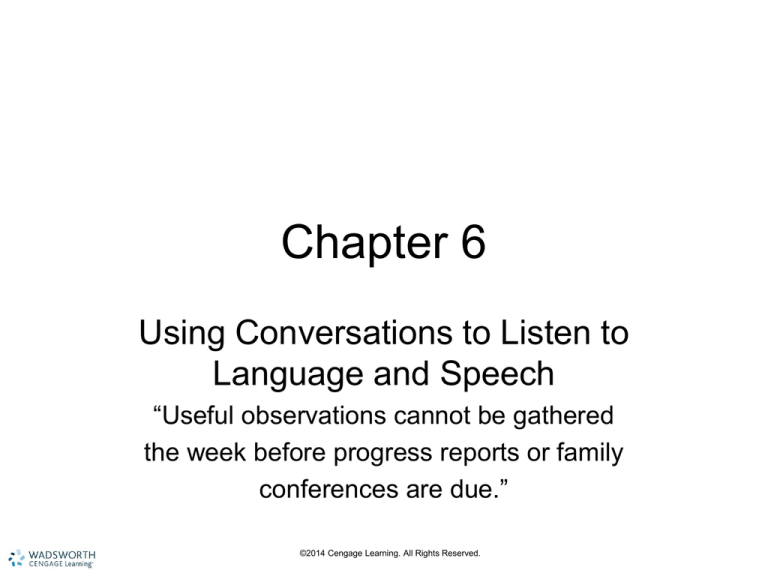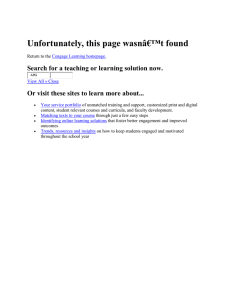
Chapter 6
Using Conversations to Listen to
Language and Speech
“Useful observations cannot be gathered
the week before progress reports or family
conferences are due.”
©2014 Cengage Learning. All Rights Reserved.
USING LISTENING AS AN
OBESERVATION METHOD
• Informal observation of language during
play in environments beneficial for
conversation
• Formal observations
– Child interviews with open-ended questions
– Diagnostic interviews to hear
speech/language usage
– Facilitated discussions to learn what the child
knows and feels
©2014 Cengage Learning. All Rights Reserved.
Listening
• Learning to listen is the foundation of
language development
• Documentation of conversations by
transcribing and video/audio taping
• Action research is reviewing and reflecting
on the child’s conversations
©2014 Cengage Learning. All Rights Reserved.
Uses of Conversations and
Interviews
Advantages
• Yield information
about both speech
and language
• Later analysis
• Show progress
• Indicators of
self-esteem
Disadvantages
• Time-intensive
focus on one child
• Child may be
intimidated or
uncomfortable
• May be intrusive
into confidential
areas
©2014 Cengage Learning. All Rights Reserved.
What to Do with It
• Notes or tape recordings can be filed in
the child’s portfolio/folder
• Use interests and knowledge revealed to
build curriculum
©2014 Cengage Learning. All Rights Reserved.
LISTENING TO LANGUAGE
AND SPEECH
• Acquisition – How does a child learn to talk? (perceive
and comprehend)
• Language – Meaning
– Receptive – Learning to listen
– Expressive:
Vocabulary
Grammar
Discourse (written or spoken communication)
Pragmatics (practical, casual – not formal language)
Speech – Phonology: sounds of words
©2014 Cengage Learning. All Rights Reserved.
Speech and Language
Development
©2014 Cengage Learning. All Rights Reserved.
Development of Language
• Beginning communication
• Functions of language
– Describe
– Communicate needs
– Commands
– Questions
– Humor
• Social and non-verbal language
©2014 Cengage Learning. All Rights Reserved.
Facilitating & Modeling Language
• Facilitating – Expanding and open-ended
questions
• Modeling – Using language to show respect
for the child, NOT
– The tester
– The helper
– “Use your words”
– “How would you like it?”
– Incorrect grammar, slang, and lazy articulation
©2014 Cengage Learning. All Rights Reserved.
Observing the Developing
Language of Infants and Toddlers
• Milestones
–
–
–
–
–
–
Responding to the spoken word, babbling
Single words to convey needs
Names objects
Short sentences
Clearer speech
More complex sentences, asks questions, uses
nouns, verbs and conjunctions
• Cause for concern when milestones are
delayed
©2014 Cengage Learning. All Rights Reserved.
HELPING ALL CHILDREN WITH
LANGUAGE DEVELOPMENT
• English as a Second Language
• Bilingual Children
• Children with Special Needs in the areas
of speech production and language
acquisition
• Helping Professions
©2014 Cengage Learning. All Rights Reserved.
TOPICS IN OBSERVATION
Diversity
• Individual Differences – Each child is
unique
• Special Needs – Development outside the
range of “normal” or “typical”
• Cultural/Ethnic diversity – Affects
development and others’ interpretations
• Names – This book deliberately uses
names from a variety of nationalities
©2014 Cengage Learning. All Rights Reserved.
Standard Relating to Language
Head Start Child Outcomes
• Speaking and Communicating
– Indicator 1:
Develops increasing abilities to understand
and use language to communicate
information, experiences, ideas, feelings,
opinions, needs, questions, and for other
varied purposes.
©2014 Cengage Learning. All Rights Reserved.





